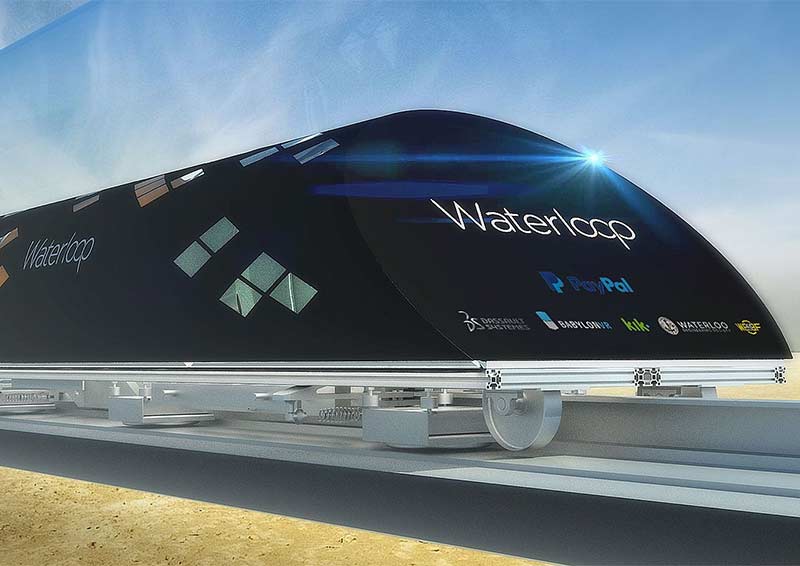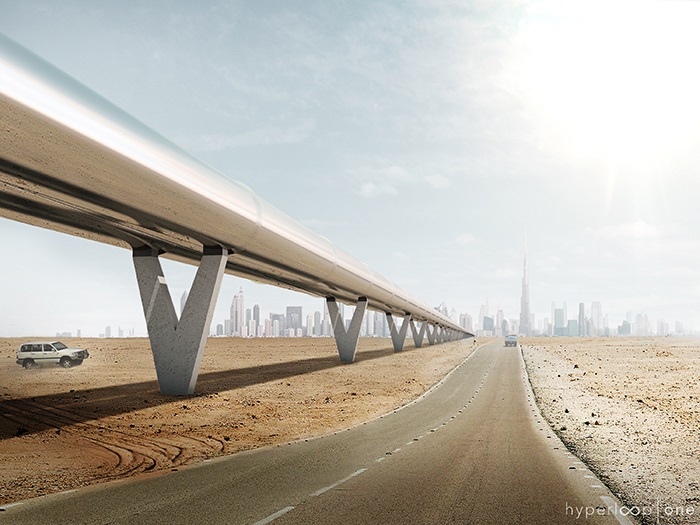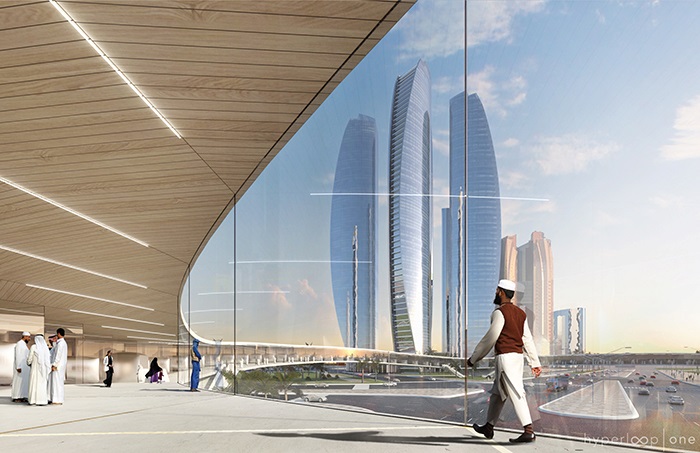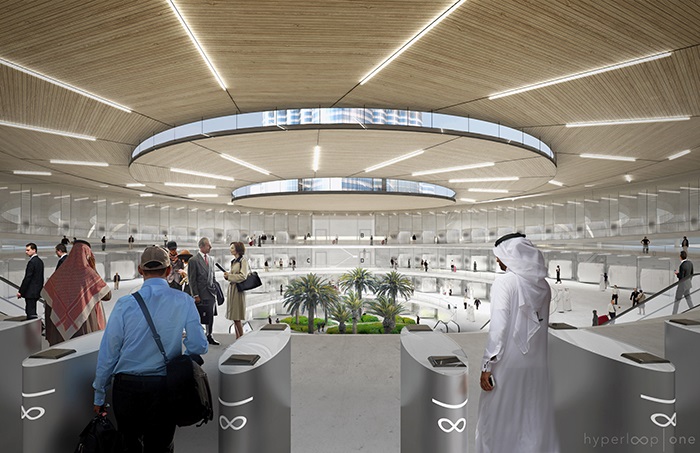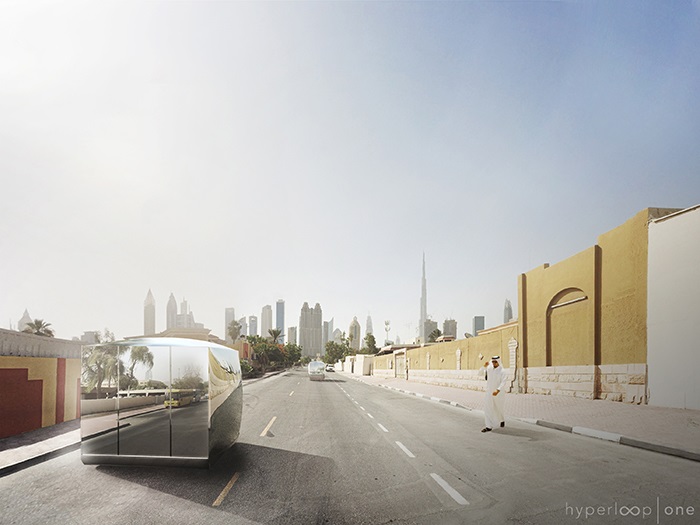Hyperloop One
In November 2016, BIG-Bjarke Ingels Group unveiled designs for an autonomous transportation system and the world’s first Hyperloop pods and portals in Dubai, UAE.
BIG and Hyperloop One have partnered on a detailed feasibility study financed by the RTA. The team has been working on the concept for autonomous transportation in the UAE since May 2016. Hyperloop One will move passengers and cargo between two points quickly, safely, efficiently and sustainably.
The proposals will reduce the current journey time between downtown Dubai to downtown Abu Dhabi from a two-hour drive to just 12 minutes.
Hyperloop is autonomous, point-to-point and aims to simplify the experience of getting from front-door to final destination.
All elements of the travel experience are designed to increase convenience and reduce interruptions. The objective is to eliminate waiting from the passenger experience. All departure gates are immediately visible upon entering the portal, and a simple numbering system allows passengers to quickly identify them.
Passengers will travel in pods that have room for 6 people. The pods are contained within a transporter, a pressure vessel attached to a chassis for levitation and propulsion that can accelerate the transporter to 1,100 km/h.
Passengers board the next pod that is available, which moves onto a transporter to their final destination. The relatively small unit-size of the pods paired with a high arrival and departure-rate allows for on-demand travel.
Different interior environments and seating arrangements offer passengers a travel experience tailored to their needs, whether travelling solo or in groups, for business meetings or casual trips.
The pods operate autonomously from the transporter, meaning that they are not limited to the portal area and can move on regular roads, picking up passengers at any point. At portals, pods are loaded onto the transporter and 'hyperjump' to another portal, where they merge onto the street and drop passengers off at their final destination.
Josh Giegel, President of Engineering, Hyperloop One, said:
"Together with BIG, we have worked on a seamless experience that starts the moment you think about being somewhere – not going somewhere. We don’t sell cars, boats, trains, or planes. We sell time.”
Bjarke Ingels, Founding Partner, BIG, said:
“Hyperloop One combines collective commuting with individual freedom at near supersonic speed. We are heading for a future where our mental map of the city is completely reconfigured, as our habitual understanding of distance and proximity – time and space – is warped by this virgin form of travel.”
Based in Los Angeles, Hyperloop has some of the world’s leading experts in engineering, technology and transport project delivery, working in tandem with global partners and investors to make Hyperloop a reality.
Content and images courtesy of Hyperloop.
For a Hindi translation of this article, see here.
For a Urdu translation of the article, click here
[edit] Find out more
[edit] Related articles on Designing Buildings Wiki
- 2 hours to 30 minutes. This is what our technology could do to your commute.
- 7 Engineering Wonders of the World.
- CarTube.
- Crossrail 2.
- Engineering smart cities.
- High Speed 2 (HS2).
- Hyperloop in Dubai.
- Infrastructure.
- Smart motorway.
- Sustainable transport.
- The challenges facing Hyperloop One.
- The transport revolution of Hyperloop.
- Transit Elevated Bus (TEB).
- Transport design and health.
Featured articles and news
Professional practical experience for Architects in training
The long process to transform the nature of education and professional practical experience in the Architecture profession following recent reports.
A people-first approach to retrofit
Moving away from the destructive paradigm of fabric-first.
International Electrician Day, 10 June 2025
Celebrating the role of electrical engineers from André-Marie Amperè, today and for the future.
New guide for clients launched at Houses of Parliament
'There has never been a more important time for clients to step up and ...ask the right questions'
The impact of recycled slate tiles
Innovation across the decades.
EPC changes for existing buildings
Changes and their context as the new RdSAP methodology comes into use from 15 June.
Skills England publishes Sector skills needs assessments
Priority areas relating to the built environment highlighted and described in brief.
BSRIA HVAC Market Watch - May 2025 Edition
Heat Pump Market Outlook: Policy, Performance & Refrigerant Trends for 2025–2028.
Committing to EDI in construction with CIOB
Built Environment professional bodies deepen commitment to EDI with two new signatories: CIAT and CICES.
Government Grenfell progress report at a glance
Line by line recomendation overview, with links to more details.
An engaging and lively review of his professional life.
Sustainable heating for listed buildings
A problem that needs to be approached intelligently.
50th Golden anniversary ECA Edmundson apprentice award
Deadline for entries has been extended to Friday 27 June, so don't miss out!
CIAT at the London Festival of Architecture
Designing for Everyone: Breaking Barriers in Inclusive Architecture.
Mixed reactions to apprenticeship and skills reform 2025
A 'welcome shift' for some and a 'backwards step' for others.







